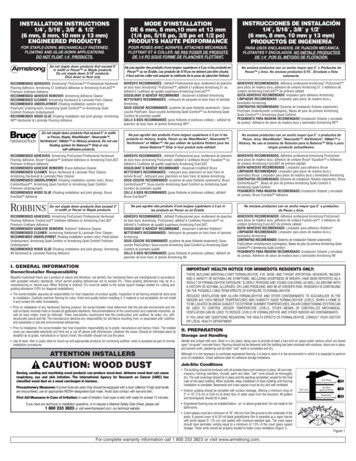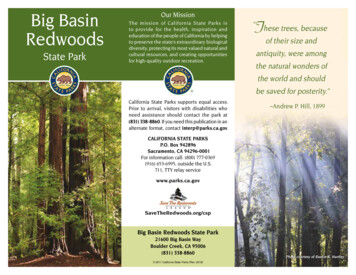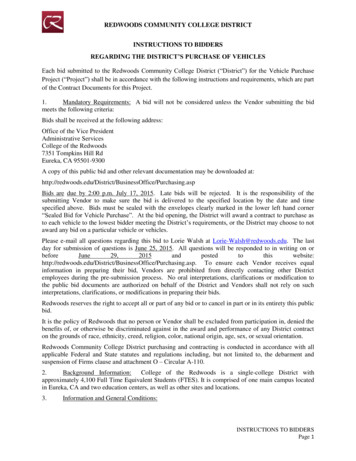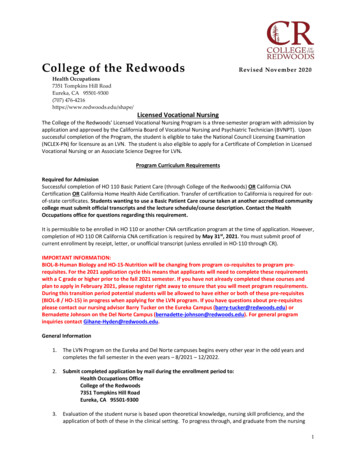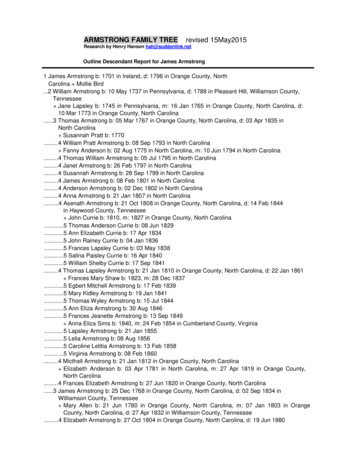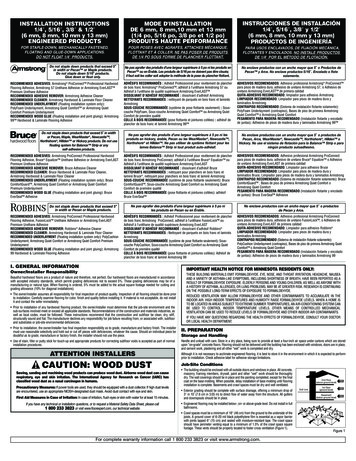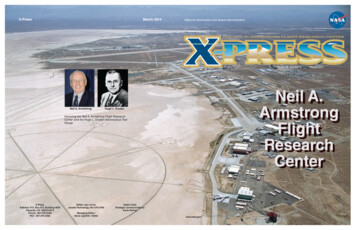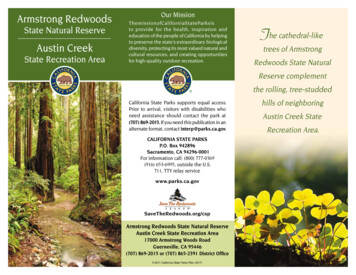
Transcription
Armstrong RedwoodsState Natural ReserveAustin CreekState Recreation AreaOur MissionThe mission of California State Parks isto provide for the health, inspiration andeducation of the people of California by helpingto preserve the state’s extraordinary biologicaldiversity, protecting its most valued natural andcultural resources, and creating opportunitiesfor high-quality outdoor recreation.The cathedral-liketrees of ArmstrongRedwoods State NaturalReserve complementthe rolling, tree-studdedCalifornia State Parks supports equal access.Prior to arrival, visitors with disabilities whoneed assistance should contact the park at(707) 869-2015. If you need this publication in analternate format, contact interp@parks.ca.gov.CALIFORNIA STATE PARKSP.O. Box 942896Sacramento, CA 94296-0001For information call: (800) 777-0369(916) 653-6995, outside the U.S.711, TTY relay trong Redwoods State Natural ReserveAustin Creek State Recreation Area17000 Armstrong Woods RoadGuerneville, CA 95446(707) 869-2015 or (707) 865-2391 District Office 2011 California State Parks (Rev. 2017)hills of neighboringAustin Creek StateRecreation Area.
Armstrong Redwoods State NaturalReserve and Austin Creek State RecreationArea share a boundary, but the parks arequite different from each other. Serene,805-acre Armstrong Redwoods — shadedby ancient coast redwoods — has been acool summer escape for generations of parkvisitors. Temperatures are moderate, with fogyear-round. The nearly 6,000 tree-studdedacres of Austin Creek provide a bright, sunnyplace best experienced in spring and fall;summer temperatures here can reach100 degrees.PARK HISTORYNative PeopleBefore the early 1800s, the Kashaya Pomopeople lived along the coast and what isnow called the Russian River. The ocean andthe river’s plentiful resources sustained theKashaya people.With the construction of nearby Fort Ross in1812, the lives of the Kashaya were abruptlyaltered. Fur trappers from the RussianAmerican Fur Company arrived at the fort,seeking sea otter pelts and a place to growfood for their Alaskan outpost. For nearly30 years, the Russians employed numerousKashaya Pomo people as agriculturallaborers—many of whom lived around the fortor in nearby villages. Some Kashaya womenintermarried with the Russian immigrants.Today Kashaya Pomo and other nativegroups still live in or visit the area to gatherleaves, roots, and other natural ingredientsneeded to make some of the world’s finest,most sought-after Native American baskets.Colonel James B. ArmstrongOhio native Colonel James B. Armstrongwas one of the very few 19th-century lumberbarons who appreciated both the intrinsicbeauty and the commercial uses of theredwood groves.In 1874 Armstrong moved to SonomaCounty with his wife and family. They builttheir home in Cloverdale, where he investedin orchards and real estate there and in SantaRosa. Working with crop plants, ColonelArmstrong became a lifelong friend ofagricultural pioneer Luther Burbank.Upon his arrival in Sonoma County,Armstrong began to purchase land in thedense redwood forest 2.5 miles north ofGuerneville. He saw that thousands of acresof seemingly inexhaustible redwoods werebeing reduced to clear-cut tree stumps(thus inspiring Guerneville’s original name,Colonel James Armstrongin 1883Elizabeth ArmstrongJones, ca. 1900Colonel Armstrong Tree“Stumptown”). To preserve some of hisland from this fate, he deeded 600 acres ofthe ancient forest to his daughter Kate, withplans for an arboretum and natural park.The Armstrong family allowed the publicto visit and enjoy the beauty of thepeaceful redwoods.Armstrong later bought the Big BottomSawmill and cut and processed millions offeet of redwood lumber. The redwoods hehad deeded to Kate remained intact; 400 ofthose acres eventually became ArmstrongRedwoods State Natural Reserve (SNR).Armstrong’s other daughter Elizabeth(Lizzie) and her husband, Reverend
William Ladd Jones, dedicated the ColonelArmstrong Tree. This “monarch of theforest,” chosen before his death in 1900,commemorates Armstrong’s vision ofsaving ancient redwoods.The State of California acquired the grovein 1934; by 1936 Armstrong Redwoods StatePark was open to the public.Armstrong Redwoods became a reservein 1964, after insight into its ecologicalimportance suggested that this vitalresource should be more effectivelymanaged. That same year, the State beganacquiring the land which now comprisesAustin Creek State Recreation Area (SRA) toprovide camping and recreational facilitiesand preserve important wildlife corridors.Since then, Save the Redwoods Leaguehas protected nearly 1,700 acres in AustinCreek SRA.NATURAL HISTORYThe remaining coast redwoods (Sequoiatree voles. Hound’s tongueand common madia makeseasonal displays in thesparse understory, which isalso home to wood rats andalligator lizards.Oak Woodland —This habitat includesCalifornia buckeye,manzanita, Oregon whiteoak, and California blackoak. Band-tailed pigeons,The popular Redwood Forest Theater was built in 1934. king snakes, and gray foxeslive here. Checker lilies may be found amongsempervirens), the tallest living trees onthe oaks.Earth, now grow naturally only along a narrowRiparian — Along rivers, streams and othercoastal belt from southern Oregon to centralwaterways, wood ferns, bracken ferns, andCalifornia. The wet fog that shrouds thismaidenhair ferns thrive. White and red alder,ancient, temperate rainforest helps maintainchain fern, giant horsetail, western azaleas,the moist conditions that the trees — and theand various mosses shelter California newts,wildlife that depend on them — need to exist.Pacific tree frogs, American dippers, andToday, scientists are studying the effects ofbelted kingfishers.climate change on redwoods.Great blue heronsHabitats and Wildlifefish in streamsThe area’s distinct habitats shelter a widefor coho salmon,range of native wildlife.steelhead, or redRedwood — Coast redwoods shade forestlegged frogs as riverfloor plants such as redwood sorrel, trillium,otters play.calypso orchids, and sword and brackenferns. Look for banana slugs, myotis bats,and black-tailed mule deer.Mixed Evergreen / Douglas-Fir — Alongridges and slopes grow a mix of Douglasfir, Pacific madrone, tanoak, and Californiabay laurel. These trees house northernspotted owls, pileated woodpeckers, and
Closed-Cone Cypress — Sargent’s cypressstands grow on serpentine rock outcrops.Chaparral — Chamise, manzanita, and stickymonkeyflower make up this habitat. Deepin tangles and thorns, white-footed mice,California quail, and other small prey hidefrom gray foxes. Bobcats may be spottedhunting in chaparral and grassland areas,bordered by a mixed conifer forest.Grasslands — Native purple needlegrass andCalifornia oatgrass grow wild. Soap plant,clarkia, globe lily, and other wildflowers feedand shelter black-tailed jackrabbits, Oregonjuncos, western fence lizards, gopher snakes,and garter snakes.RECREATIONAL ACTIVITIESTrails — Hikers on 20 miles of trails find itnecessary to carry plenty of water at AustinCreek, where summer temperatures can beextremely warm.Equestrians — Park trails are open seasonallyto horses; horse trailers are not allowedbeyond the picnic area at ArmstrongRedwoods SNR. For trail conditions, call(707) 869-2015.Banana slugBicycles — Ride bicycles only on pavedand unpaved fire roads, not on trails. AtAustin Creek, the paved and unpavedfire roads gain 1,000 feet of elevation. AtArmstrong Redwoods, bicyclists must sharethe flat, paved road with hikers, horses,and vehicles.Camping — At Austin Creek, camping isavailable year round. Some campsitesare first-come, first-served; others can bereserved at www.hipcamp.com. Sites havetables and fire rings with nearby flush toiletsand drinkable water (but no showers). Forquestions, call Stewards at (707) 869-9177.Backcountry (Primitive) Camping — The nonreservable Tom King and Mannings Flat hikein campsites require permits for backcountrycamping, available when the entry kiosk orvolunteer center are open. Sites have tables,fire rings, and nearby pit toilets. Water fromthe year-round stream must be purifiedbefore drinking.When camping is allowed, register andget a permit for Austin Creek camping at theArmstrong Redwoods SNR entry kiosk. If staffis absent, contact Stewards at (707) 869-9177or stewards@stewardscr.org.Facilities — The reserve has a visitorcenter, outdoor amphitheater, picnicfacilities, and about nine miles of hikingtrails. The visitor center (nature store) hasinterpretive displays and sells a variety ofeducational items.Two picnic areas in the redwoods are¾ mile from the park entrance. NearbyFife Creek runs swiftly in winter and slowsor dries in spring, summer, and fall. ABullfrog Pond
seasonal waterfall is close by. Amenitiesinclude picnic tables, barbecue grills andpit, and restrooms. For group picnic areareservations, call (707) 865-2394.Pond Farm PotteryShortly after World War II,internationally known ceramic artistMarguerite Wildenhain acceptedan invitation from Gordon and JaneHerr to move to their art colony(now part of Austin Creek SRA).Wildenhain lived, worked, andtaught at Pond Farm until her deathin 1985. In 2014, Pond Farm wasadded to the National Register ofHistoric Places.Annual Events — Armstrong is home to manyannual events. The Old Grove Festival takesplace in September. For an event calendar,visit www.parks.ca.gov.ACCESSIBLE FEATURESArmstrong RedwoodsPicnic Area — Accessible picnic sites arenear the trailhead at Pool Ridge Trail.Parking — Routes of travel from parking areato accessible sites are paved, but help maybe needed with slopes.Exhibits / Programs — The visitor center isaccessible; wheelchair users may need helpwith ramp and path slopes.Trails — The accessible Discovery,Armstrong, and Pioneer Nature Trailsthrough the redwoods are self-guided.Austin CreekCurrently there are no accessible featuresat this park. Accessibility is continuallyimproving. For updates, visithttp://access.parks.ca.gov.Bullfrog Pond CampgroundPLEASE REMEMBER All park features are protected by law andmay not be disturbed in any way. Stay on designated trails. Off-trail walkingand riding cause soil erosion, damageredwood root systems, and expose visitors toticks, snakes, and poison oak. Vehicles are permitted only on paved roads.When meeting oncoming traffic in AustinCreek SRA, vehicles traveling downhill mustyield to uphill traffic. Vehicles more than 20 feet long or towingtrailers may not use the narrow, steep parkroad up to Bullfrog Campground. Except for service animals, dogs arepermitted only on paved roads in bothparks. Dogs must be on leash. Hunting and the possession of weapons areprohibited anywhere in the parks. Fishing is available only in Bullfrog Pond. Allstreams are closed to fishing to protect vitalspawning habitat.NEARBY STATE PARKS Fort Ross State Historic Park19005 Highway 1Jenner, CA 95450(707) 847-3286 Sonoma Coast State Park3095 Highway 1Bodega Bay, CA 94923(707) 875-3483 or(707) 865-2391Austin Creek SRA is currentlyoperated by Stewards of the Coastand Redwoods. Both state parksreceive support throughthis nonprofit organization.For more information, contact:Stewards of the Coastand RedwoodsP.O. Box 2, Duncans Mills, CA 95430(707) 869-9177www.stewardscr.org
RiRockyMountainggs1719ft524mS tate R ecre ation AreatoEast AustinCreek FireRoadreekGray 50.50.751 Mile0.40.81.21.6 Kilometersay C800reekVista PointDay UseParking Area10001200120060P R I V AT E6001400MP R O P E RT Y80040Cmll iaei Riil200Redw0.2oo400rest0.1ods RdWong600FotoGuerneville,Hwy. 1160.2omst rAr800dature TrailrNee 0.2onPidoa0.4 t e r RaTheHul b e rt10.1.2a30. ong NtrdgaTr00.2VisitorCentereCre e kPool RidgeTrail16000.40.40to EastRidge TrailArm0.2 strod0.4RoangWoodsPioneer Nature TraililTraPP R O P E RT Yr o0.2t0RedwoodForestTheaterP R I V AT EWaterfallseedetail unteerOfficemstAr60ARMSTRONGREDWOODS.9S TAT EPoolN AT U R A L RR E S E RV E0.3CrRdFire0.5l0East AustinTrailhead0.MarconiConferenceCenter SHPRanger StationWaterfall0.6PondFarmPotteryiTr aoPo l Rid ge40400Primitive Campsite1200ViewpointPRdTrailCKPicnic Areak30.eBASt ate Natural Res erveMileage MarkersRestrooms0600BONE0.240800D E V I L’ SilArmstrong Redwoods10000Locked GateParkingilod sWodg800.5P R O P E R T Y1600ee140000sRi01600P R I V AT ETrat ro 0.8ng1.440060PPool200r141919ft585m14000.6Ar mP R O P E RT YEast0 .20.510Pool RidgeTrailhead80060016001000P R I V AT E10000.PGilliam CreekTrailhead200e ekRigSchoolhouseFlat Day Use800800ACSRA60040060400lamFioadeRF irGroup Picnic Area1200HorseStaging AreaMcCrayMountainRoek400Cr e1.2Ridgest 7geRid400in0600stAuP0.60 .3DGE80060RI1000Gil lirailkTeeCrkreeE2.0am11800060feCreRidge1200Fil h4o0u0y1000Campfire CenterTr ailhooaCreSc0keeCrkS14r40see detailmap aboveright0. P4Day Use800Camp Host #4Campsite Numbers1-2414000kGilliamC40oadire R1.5Gk TrailreeekrekFAEast us t in Cree0.800Campground00001. 7141000Accessible Feature1200Gilliam Creekse0 .2ocUIntermittent Stream00161. 0ROBLUE GRckC1.4gs060McreBla12G illiam C r e ek10001FiRoad1000Ea0010n1000800adRoreFiMount3ai0 .6Trail: Hiking and HorseAccessible1200Trail1400NSO800ekreCFoxGde Ro aEastAu1. stinRoadreFi0MOIRRID0. 31.11358ft414m80RTrail: Hiking Only11200EFiFoxMountainGE60.inntaouM1000600Tom KingCampsitexFo800P R O P E RT YRIDeekmpson CrTho0600P R I V AT EONUnpaved Road060Fi fe CrkRoadPaved Road1916ft584m1400adee1800P R O P E RT Y0Cr40nPSP R I V AT EQueensPeakE ast R i d g e TraileOMrFist iTH600Legend16000.2CrAuE0M c e CreMannings FlatCampsite IAREAkee1312ft400mEast Austin1000East RidgeFire RoadBULLFROG PONDCAMPGROUND00LEopLo TraBlackRock14RB1200R E C R E AT I O NMannings FlatCampsite IIARidgeS TAT ESelfRegistration10000.8AU S T I N C R E E K100040060010000800400Grat ure1000A rmsAusCreektinstRoadBullfrogPondAustin CreekEaeFir8001000ParsonJonesTreeKioskVisitor Center2.5 miles 2011 California State Parks (Rev. 2017)
Armstrong Tree. This "monarch of the forest," chosen before his death in 1900, commemorates Armstrong's vision of saving ancient redwoods. The State of California acquired the grove in 1934; by 1936 Armstrong Redwoods State Park was open to the public. Armstrong Redwoods became a reserve in 1964, after insight into its ecological
